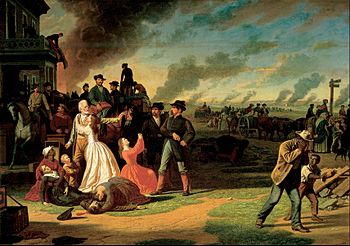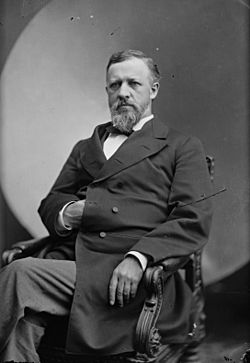Thomas Ewing Jr. facts for kids
Quick facts for kids
Thomas Ewing Jr.
|
|
|---|---|

General Thomas Ewing Jr.
|
|
| Member of the U.S. House of Representatives from Ohio |
|
| In office March 4, 1877 – March 3, 1881 |
|
| Preceded by | Ansel T. Walling |
| Succeeded by | John B. Rice |
| Constituency | 12th district (1877–1879) 10th district (1879–1881) |
| Personal details | |
| Born | August 7, 1829 Lancaster, Ohio, U.S. |
| Died | January 21, 1896 (aged 66) New York City, New York, U.S. |
| Military service | |
| Allegiance | United States of America Union |
| Branch/service | United States Army Union Army |
| Years of service | 1862 – 1865 |
| Rank | |
| Battles/wars | American Civil War |
Thomas Ewing Jr. (born August 7, 1829 – died January 21, 1896) was an important figure in American history. He was a lawyer, the very first chief justice of Kansas, and a strong supporter of Kansas becoming a free state. During the American Civil War, he served as a general in the Union Army. Later, he became a United States Congressman for Ohio, serving two terms from 1877 to 1881. He also ran for Ohio Governor in 1879 but lost by a small margin.
Contents
Early Life and Family
Thomas Ewing Jr. was born in Lancaster, Ohio. His father, Thomas Ewing Sr., was a very successful lawyer and politician. The family was Catholic. Thomas Ewing Jr. had a special connection to William Tecumseh Sherman. Sherman was his foster brother and later became his brother-in-law when he married Thomas's sister, Eleanor "Ellen" Ewing Sherman. Two of Thomas's other brothers, Charles Ewing and Hugh Boyle Ewing, also became generals in the Civil War. Thomas and William Tecumseh Sherman remained close friends throughout their lives.
Education and Early Career
Thomas Ewing Jr. started his college education at Brown University in Providence, Rhode Island. He left college to work as a private secretary for President Zachary Taylor from 1849 to 1850. After that, he studied and practiced law in Cincinnati, Ohio, from 1852 to 1856. He earned his law degree from Cincinnati Law School in 1855.
On January 18, 1856, Ewing married Ellen Cox. He then moved to Leavenworth, Kansas, later that year. In Kansas, he became a member of the Leavenworth Constitutional Convention in 1858. He also supported building a railroad across the country. He owned part of the Leavenworth, Pawnee and Western Railroad, which later became part of the Union Pacific Railroad.
Kansas and Slavery
Ewing had balanced views on the issue of slavery. He worked to stop the Lecompton Constitution, which would have allowed slavery in Kansas. His efforts helped Kansas join the United States as a free state. This was achieved without the violent conflicts that some other anti-slavery leaders wanted. In 1861, he was a representative for Kansas at the Peace Conference of 1861. He was also chosen as the first chief justice of the new state of Kansas in 1861.
During the Civil War

In 1862, Ewing left his job as a judge to join the military. He helped create the 11th Kansas Infantry and became its first colonel. His regiment fought in several battles, including Old Fort Wayne, Cane Hill, and Prairie Grove.
Even though he had no military experience before the war, Ewing was promoted to brigadier general in March 1863. This was because of his strong leadership at the Battle of Prairie Grove. He was then put in charge of the District of the Border, which included Kansas and western Missouri.
General Order No. 11
Ewing became known for General Order № 11. He issued this order after William Quantrill's raid on Lawrence, Kansas. In that raid, 150 men and boys were killed. General Order No. 11 forced civilians who supported the Southern cause to leave four counties in Missouri. If they didn't leave on their own, Union soldiers would make them. This order was meant to stop guerrilla fighters, but it was a very tough decision and left a lasting mark on his reputation.
In September and October 1864, Ewing helped stop Sterling Price's invasion of Missouri. He was the deputy commander of the St. Louis district. He led a successful defense at Fort Davidson in Pilot Knob, Missouri. His small group of about 1,500 soldiers fought off around 15,000 Confederate soldiers. This brave stand gave the Union army more time to prepare defenses around St. Louis. Instead of giving up, Ewing and his men escaped during the night. They then fought their way back to Rolla, Missouri.
On February 23, 1865, Ewing left the military to return to his life as a civilian. He gave his resignation directly to his friend, President Abraham Lincoln. A month later, Lincoln was assassinated. On February 24, 1866, President Andrew Johnson nominated Ewing to receive the honorary rank of major general of volunteers. The U.S. Senate approved this on May 4, 1866.
After the War
After the Civil War, Thomas Ewing Jr. remained a good friend of Abraham Lincoln. After Lincoln's assassination, Ewing became involved in the trials of those accused of being part of the plot. He represented three people: John Ford's employees, Samuel Arnold, and Edmund Spangler. He also helped the family of Dr. Samuel Mudd get legal help. Ewing's efforts saved these three men from execution. They were instead sent to prison at Fort Jefferson in the Dry Tortugas off Key West, Florida.
From 1865 to 1870, Ewing worked as a lawyer in Washington, D.C.. He used his influence to help people from the Southern states. He also played a role in defending President Andrew Johnson when some politicians tried to remove him from office. Ewing convinced a key senator, Edmund G. Ross, to vote against removing President Johnson. Ewing also helped Dr. Mudd get a pardon at the end of Johnson's presidency.
In 1870, he moved back to his hometown of Lancaster, Ohio. He practiced law there for ten years and tried some business investments. Ewing was also a member of the Ohio state Constitutional Convention in 1873 and 1874.
Serving in Congress
In 1876, Thomas Ewing Jr. was elected to the United States House of Representatives as a Democrat. He was re-elected in 1878. He served in Congress from 1877 to 1881. During his time in Congress, he worked on a bill to create a Bureau of Labor Statistics. He also spoke out against having U.S. soldiers at election places. He supported using silver as money again and keeping the Greenback currency. He became a leading voice for the Greenback Party.
Running for Governor
In 1879, Ewing ran for Governor of Ohio as the Democratic candidate. He lost the election by a small number of votes. Some historians believe that the use of George Caleb Bingham's famous painting of General Order № 11 in the campaign against Ewing might have made a difference in the election.
On March 3, 1881, Ewing finished his second term in Congress. He then moved to New York to continue his law career. He never ran for public office again.
Later Achievements
Ewing founded and was the first president of the Ohio Society of New York. He also served as a trustee for the Ohio Soldiers' and Sailors' Orphans' Home and Ohio University. In 1881, he became the Vice President of the Cincinnati Law School. He gave important speeches and wrote an article called "The Struggle for Freedom in Kansas." Brown University later gave him a bachelor's degree in 1894. Georgetown College gave him an honorary law degree in 1870.
Thomas Ewing Jr. died in 1896 after being hit by a bus in New York City. He is buried in the Oakland Cemetery in Yonkers, New York.
See also
 In Spanish: Thomas Ewing Jr. para niños
In Spanish: Thomas Ewing Jr. para niños
- List of American Civil War generals (Union)
- Bleeding Kansas
- Battle of Pilot Knob
- General Order No. 11 (1863)
- Lawrence massacre


